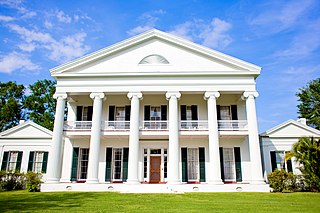
Richland Parish is a parish located in the North Louisiana Delta Country in the U.S. state of Louisiana, known for its fertile, flat farmland, cane brakes, and open spaces. The parish had a population of 20,043 at the 2020 United States census. The name Richland was chosen due to the rich production from farming. The parish seat and largest community is Rayville.

Madison Parish is a parish located on the northeastern border of the U.S. state of Louisiana, in the delta lowlands along the Mississippi River. As of the 2020 census, the population was 10,017. Its parish seat is Tallulah. The parish was formed in 1839.

East Carroll Parish is a parish located in the Mississippi Delta in northeastern Louisiana. As of 2020, its population was 7,459. The parish seat is Lake Providence. An area of cotton plantations in the antebellum era, the parish in the early 21st century has about 74% of its land devoted to agriculture.

Tallulah is a city in, and the parish seat of, Madison Parish in northeastern Louisiana, United States. As of the 2020 census, the population was 6,286, down from 7,335 in 2010.

Franklin is a small city in and the parish seat of St. Mary Parish, Louisiana, United States. The population was 7,660 at the 2010 census. The city is located on Bayou Teche, southeast of the cities of Lafayette, 47 miles (76 km) and New Iberia, 28 miles (45 km), and 22 miles (35 km) northwest of Morgan City. It is part of the Morgan City Micropolitan Statistical Area and the larger Lafayette-Acadiana combined statistical area.

The Tensas River is a river in Louisiana in the United States. The river, known as Tensas Bayou in its upper reaches, begins in East Carroll Parish in the northeast corner of the state and runs roughly southwest for 177 miles (285 km) more or less in parallel with the Mississippi River. The Tensas River merges with the Ouachita River in Jonesville in Catahoula Parish to become the Black River, not to be confused with Black Lake in Natchitoches Parish in north central Louisiana.

Oak Alley Plantation is a historic plantation located on the west bank of the Mississippi River, in the community of Vacherie, St. James Parish, Louisiana, U.S. Oak Alley is named for its distinguishing visual feature, an alley or canopied path, created by a double row of southern live oak trees about 800 feet long, planted in the early 18th century — long before the present house was built. The allée or tree avenue runs between the home and the River. The property was designated a National Historic Landmark for its architecture and landscaping, and for the agricultural innovation of grafting pecan trees, performed there in 1846–47 by a gardener. It was first known as Bon Séjour.

Madewood Plantation House, also known as Madewood, is a former sugarcane plantation house on Bayou Lafourche, near Napoleonville, Louisiana. It is located approximately two miles east of Napoleonville on Louisiana Highway 308. A National Historic Landmark, the 1846 house is architecturally significant as the first major work of Henry Howard, and as one of the finest Greek Revival plantation houses in the American South.

The Kate Chopin House, also known as the Bayou Folk Museum or Alexis Cloutier House, was a house in Cloutierville, Louisiana. It was the home of Kate Chopin, author of The Awakening, after her marriage.

Hermione, now the Hermione Museum, is a Greek Revival-style plantation house built in 1853 or 1855 on Kell Plantation in Madison Parish, Louisiana. In 1997 it was donated to the Madison Historical Society and moved to the parish seat of Tallulah.

Montrose Plantation House is a Greek Revival-style plantation house built in about 1880 which is located in Madison Parish, Louisiana, on Louisiana Highway 603 about 6.5 miles SE of Tallulah. It was added to the National Register of Historic Places on October 5, 1982.

Scottland Plantation House is located in Tallulah, Louisiana. It was built in 1860 and was added to the National Register of Historic Places on November 2, 1982.

Rienzi Plantation House is a historic mansion located at 215 East Bayou Road in Thibodaux, Louisiana.

Ardoyne Plantation House is located on Highway 311 in Schriever, Louisiana, just northwest of Houma, Louisiana. It was built 1894 and added to the National Register of Historic Places on November 1, 1982.
The Tallulah Men's Club Building, also known as the Tallulah Club, is a two-story brick Colonial Revival building that was built in c.1929. It was listed on the National Register of Historic Places on November 7, 1991.

Chretien Point Plantation is a pre-Civil War twelve room red brick mansion, located on twenty acres on the banks of Bayou Bourbeaux, two miles southwest of Sunset, Louisiana in St. Landry Parish. A Civil War battle was fought on the plantation grounds and Jean Lafitte was a tenant. The mansion was listed on the National Register of Historic Places in 1977.

The Seward Plantation is a historic site built in 1855, a Southern plantation-turned-ranch located in Independence, Texas. The Seward Plantation has been listed on the National Register of Historic Places since January 29, 2013. It was documented as part of the Historical American Buildings Survey. It has a Texas Centennial Marker.
The Dulcito Plantation is a historic house built c. 1850, and formally was a Southern sugar plantation, located at 5918 West Old Spanish Trail near New Iberia, Louisiana. This is one of the few remaining buildings of the area that highlights the pre-Civil War architectural heritage, despite having some alterations. The house was listed on the National Register of Historic Places on July 22, 1994.
The Bear Lake Club, Ltd., Clubhouse near Tallulah, Louisiana was built around 1905 and was listed on the National Register of Historic Places on March 2, 2001.

The Alice C Plantation House, also known simply as the Alice Plantation House, is a historic former plantation house, located in Garden City near Franklin in St. Mary Parish, Louisiana.






















